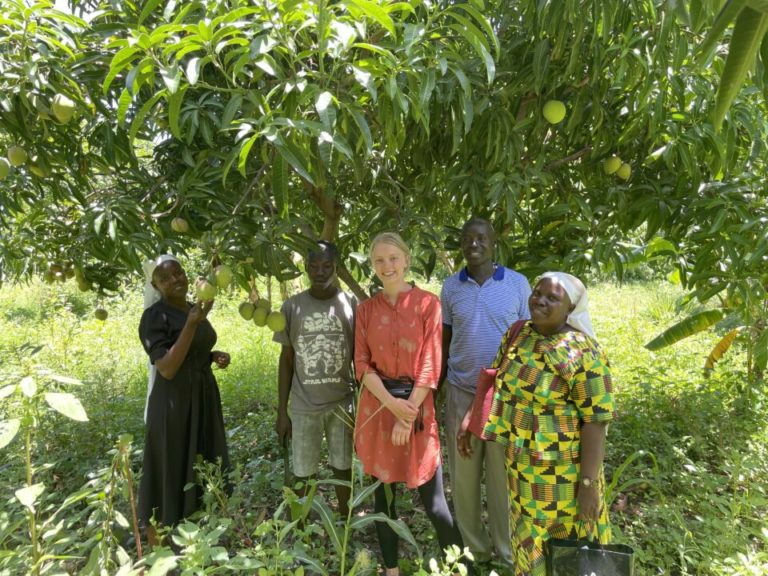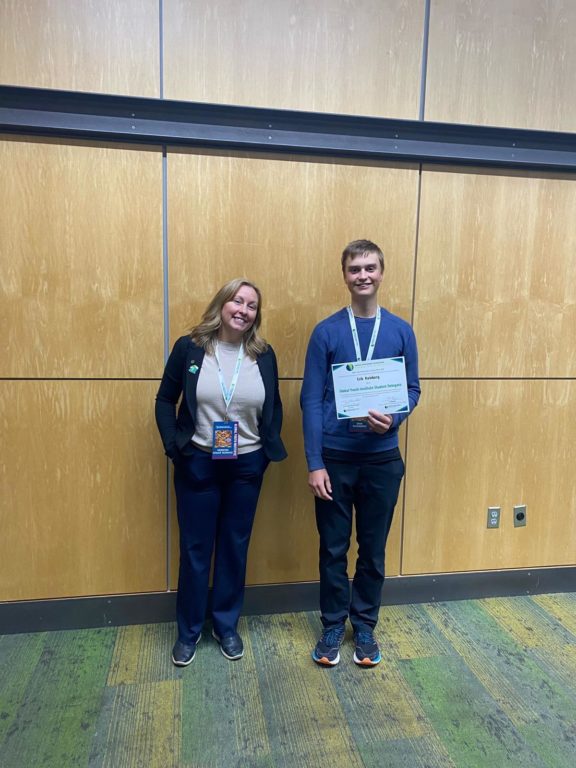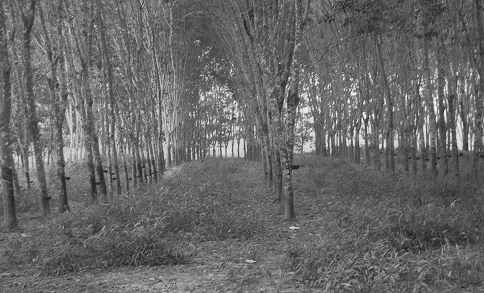Written by Max Johansson, student at the Landscape engineering programme in Alnarp, about his Bachelor’s thesis in Thailand.
In January 2025 I happily received the Minor Fields Study grant through SLU Global, financed by Sida. This grant made it possible for me to write my bachelor thesis about Magnolia in Thailand and to see these fantastic trees up close.
My journey starts in the capital of Thailand, Bangkok or Krung Thep – which is a shorter version of the very long, here translated to English, full name of the city that reads: ‘’City of Angels, great city of immortals, magnificent city of nine gems, seat of the king, city of royal palaces, home of gods incarnate, erected by Vishvakarman at Indra’s behest.’’ With such a fancy name you can only begin to think that the city has a lot in store for any visitor.
My supervisor and help in the country Dr. Voradol Chamchumroon welcomed me to the BKF Herbarium at the Royal Forest Department. At BKF their mission is to complete and categorize the floras of Thailand, and luckily enough for me, the magnolia flora of Thailand had already been completed and systemized in their collection. This allowed me to examine dry specimens up close. The dry specimens does not contain preserved flowers but dried leaves and pods with seeds are still interesting to look at, I indeed spent almost two whole days scrolling through the filing cabinets containing Magnoliaceae specimens. Besides this the building of the BKF contained many interesting live specimens mainly from guesting researchers that have come to Thailand and given names to earlierly undiscovered species.

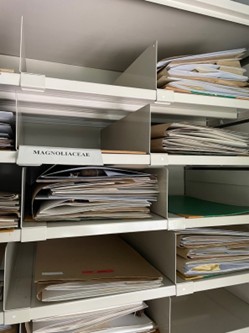
Building of BKF Herbarium and filing cabinet containing dry specimens.
My thesis focuses on the magnolias native to Thailand with the aim of exploring the possibilities for hybridization with temperate magnolias, and in extension to broaden available information for future hybridization efforts. I have focused on genetic compatibility between magnolia species and sections as well as researching the cultural importance of Thailands magnolias and also looking at their aesthetic values.
When one thinks of Thailand what first comes to mind are beaches and coconuts, but that is not where you find the special and beautiful Magnolia but rather in the mountains. I traveled to the north of Thailand to the outskirts of Chiang Mai, a cooler and mountaineous province which offers a great climate for these trees. Well there I visited the magnolia- garden and collection of Satha Suesatchan whom I had established contact with prior to leaving for Thailand. In his garden I could view several native magnolias up close in different sizes and ages. Two species that were mentioned by practically everyone were the Champee and Champa or Magnolia x alba and Magnolia Champaca , which I now had the luck to see in person, unfortunately they did not carry flowers at the time but I did get more chances.
My journey in search of magnolia took me to a handful of the most famous botanical gardens of Thailand but something that was truly special to me was an excursion put together by Dr. Voradol Chamchumroon. He and another botanist of BKF took me for three very filled days of magnolia viewing. In a car together from Bangkok to Khao Yai national park and further to the ancient site of Sab Champa village. The village is named after the ancient and revered Champa magnolia. Well there I got to see an entire protected area dedicated to magnolia conservation of primarily Magnolia sirindhorniae. The trip went further to Phu Kae and Khao Hin Sorn botanical gardens where at the second one I finally had the chance to see the flowering Champee. About ten trees stood in an avenue and were were cut in a very peculiar way that resembled the pollarding so famously known in Sweden.
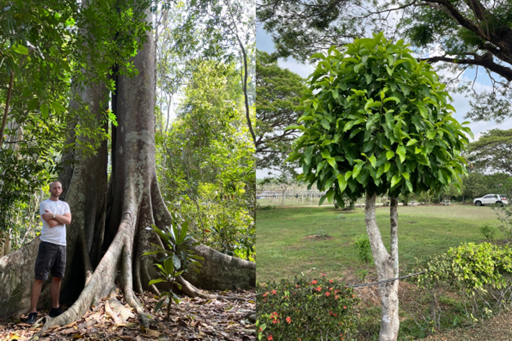
Enormous Ceiba pentandra in Khao Yai national park. Magnolia x alba in Khao Hin Sorn.
Something that really struck me were that almost nobody outside the botanical world had any idea what a magnolia tree was when I explained what I was looking for. But as soon as I said the words Champee and Champa a big smile and a very reassuring ‘’Ohhhh Champee Champaaa!’’ broke out every time. The flowers are truly known to everyone and they are commonly used for crafting Puang Malai flower garlands which is given as a gift to another person or as offering at the buddhist temples. You can see people running between cars at the red lights trying to sell the garlands from these two flowers but they are also to be seen in a plastic miniature version in every other taxi in the country.

Puang Malai from Magnolia champaca. Sab Champa magnolia conservational area.
From my interviews and talks with botanist and collectors/breeders I got to know that the Champee and Champa is so popular in Thailand because it is a very easily grown tree, it is cheap and historically readily available in most parts of the country perhaps except for the most coastal regions. So why were or are the people in Thailand need of a magnolia tree at their house? In short because they use it as offering to the temple, or simply as fragrant and beautiful flowers in their homes. The good scent of the magnolia is supposed to symbolize cleanliness or purity of ones soul, and a visit to a temple is not complete without an offering making the magnolia flowers an important element in Thai life.
More than any literature review could, simply living there would confirm to me what magnolias really are the most important to Thailand.
One challenge that arose early on was that not all trees were flowering at the same time. I planned the visits as early as possible so that I would have a ‘’face’’ to the species when I would do my literature review. Luckily I had access to the digitalized Magnoliaceae flora of Thailand from BKF. I was sent categorized pictures of ones that I had not yet seen in bloom which helped me in visualizing what a potential hybrid could possibly look like.
Towards the end of my study I was invited by the Botanical Society- and the National Biobank of Thailand to give a lecture of my own choice for their monthly seminar. I chose to talk about magnolia in Sweden and Thailand and to include findings from my thesis. I also had the chance to proudly present SLU Alnarp and the Karl Evert Flinck magnolia forest.
What is even more fun is that the National Biobank used the information I presented about the Swedish hybrid Magnolia x gotoburgensis for one of their quiz questions to win prizes.
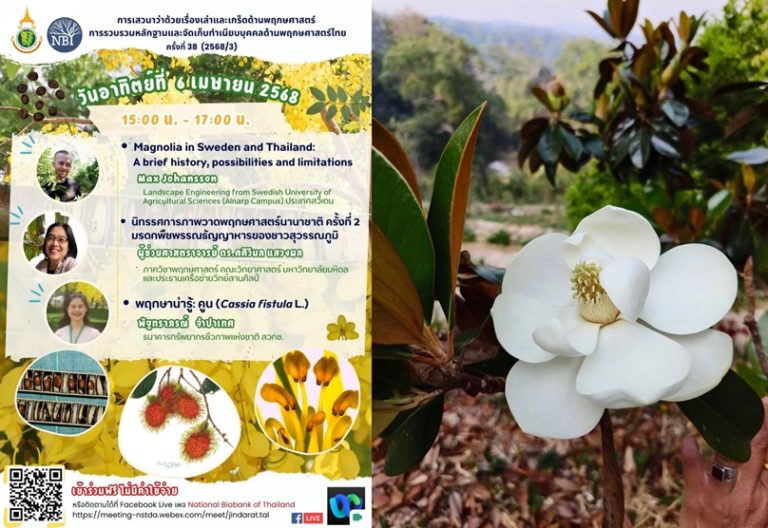
Poster from the seminar. Magnolia virginiana in Chiang Mai.
During my time in Thailand I took the opportunity to practice the language every day, and I am now proud to say that I have learnt something that years ago would seem impossible to me. I also practiced the virtues of patience and curiosity, I took every chance I could to gain knowledge and to look at all the trees and flowers in the parks and not just the magnolias. It is a powerful contrast to Sweden to see the incredible trees, flowers and leaves of all colors shapes and sizes.
Thank you to MFS and to SLU Global for giving me the truly special opportunity to conduct my bachelor thesis in another part of the world. Thanks to my supervisors Anna Levinsson and Voradol Chamchumroon for guiding and helping me. Thank you to all staff at BKF.
Max Johansson



